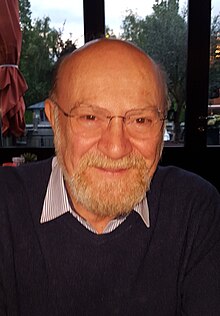Michael Aizenman
Michael Aizenman (born August 28, 1945 in Nizhny Tagil , Soviet Union ) is an Israeli-American mathematical physicist and mathematician.
Aizenman studied at the Hebrew University in Jerusalem (Bachelor degree 1969) and received his doctorate in 1975 with Joel Lebowitz at Yeshiva University (Belfer Graduate School) in New York City with the work Ergodic theory in statistical mechanics . From 1974 he was a postdoc at the Courant Institute of Mathematical Sciences of New York University and from 1975 at Princeton University with Elliott Lieb . In 1977 he became an assistant professor at Princeton, in 1982 an associate professor at Rutgers University , where he was promoted to professor in 1984. In 1987 he was back at the Courant Institute (as a professor in both the physics and mathematics departments) and from 1990 professor of physics and mathematics at Princeton. Among other things, he was visiting scholar at the Isaac Newton Institute in Cambridge (2007), at the Institute for Advanced Study (1984/85, 1991/92, 1997/98), at the Weizmann Institute, at Tel Aviv University , at ETH Zurich ( 1998), at Caltech (1992, as a Fairchild Distinguished Scholar), at the University of Paris and at IHES (1985).
Aizenman is known for work in statistical mechanics (such as phase transitions in the Ising model in three and more dimensions and quantum gases) and mathematical quantum field theory, where he proved triviality for scalar quantum field theories ( QFT) in more than four dimensions independently of Jürg Fröhlich in 1981 . He also deals with phase transitions in percolation theory (questions of conformal invariance and the sharpness of the phase transition), and disordered systems such as localization with random Schrödinger operators and spin glasses (connection to competitive particle systems via a cavity dynamics perspective). In addition to Lebowitz and Lieb, he also worked with Barry Simon , Jürg Fröhlich, Herbert Spohn and Sheldon Goldstein , among others .
From 1981 to 1984 he was a Sloan Research Fellow and 1984/85 Guggenheim Fellow. In 1990 he received the Norbert Wiener Prize and in 2002 the Brouwer Medal of the Dutch Mathematical Society . He is an honorary doctorate from Cergy-Pontoise University (2009). In 1997 he became a member of the National Academy of Sciences . Since 2001 he has been editor of Communications in Mathematical Physics. In 1983 he was invited speaker at the ICM in Warsaw (Stochastic geometry in statistical mechanics and quantum field theory). In 1982 he received the Guido Stampacchia Prize from the Scuola Normale Superiore in Pisa and in 2018 he received the Henri Poincaré Prize . In 2002 he held the Sacler Lectures in Tel Aviv. He is a fellow of the American Mathematical Society .
He has been a member of the National Academy of Sciences since 1997 . In 2010 he received the Dannie Heineman Prize for Mathematical Physics . In 2016 he was elected a member of the Academia Europaea , in 2017 of the American Academy of Arts and Sciences .
Fonts
- with Simone Warzel : Random Operators: Disorder Effects on Quantum Spectra and Dynamics AMS 2015.
- Editor: The state of matter: a volume dedicated to EH Lieb , World Scientific 1994
Web links
- Homepage in Princeton
- Aizenman Stochastic geometry and interacting fields , Nieuw Archief voor Wiskunde, June 2003 (PDF; 147 kB)
- Laudation for Aizenman von den Hollander and Enter 2003 on the occasion of receiving the Brouwer Medal, PDF file
- Biography at the APS
- Biography and acknowledgment on the occasion of the Dannie Heineman Prize
Individual evidence
- ↑ Michael Aizenman in the Mathematics Genealogy Project (English)
- ^ Aizenman, D. Barsky, R. Fernández: The Phase Transition in a General Class of Ising-Type Models is Sharp. J. Stat. Phys., Vol. 47, 1987, p. 343
- ^ Aizenman Geometric analysis of fields and Ising models , Part 1,2, Comm. Math. Phys., Volume 86, 1982, pp. 1-46
- ^ Aizenman, Proof of the Triviality of Field Theory and Some Mean-Field Features of Ising Models for d> 4. Phys. Rev. Lett., Vol. 47, 1981, p. 1
- ↑ M. Aizenman, S. Molchanov, Localization at large disorder and extreme energies: an elementary derivation, Comm. Math. Phys., Vol. 157, 1993, pp. 235-277
- ^ Member Directory: Michael Aizenman. National Academy of Sciences, accessed January 12, 2018 .
| personal data | |
|---|---|
| SURNAME | Aizenman, Michael |
| BRIEF DESCRIPTION | Israeli-American mathematician |
| DATE OF BIRTH | August 28, 1945 |
| PLACE OF BIRTH | Nizhny Tagil , Soviet Union |

